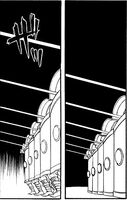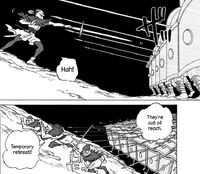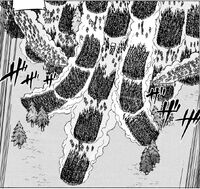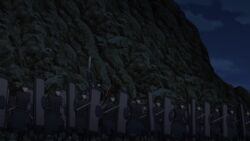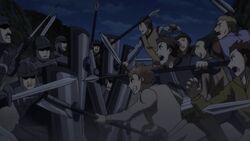The Standing Army is a light infantry of the Balt-Rhein Empire the army and Hermann Knights are regarded by Goldbalt XI as twin sword of the Balt-Rhein Empire.

Marching The Balt Rhein Standing Army
Appearance[]
Balt-Rhein's Standing Army are well equipped with light-yet durable rectangle shield for protection against arrows and sword slashes.
Equipments[]
Their main weapon is long pike-length spear but they can use a sword if situation demands so.
The long spear's main advantages is that it can be held as a one-handed weapon. This allows the army to hold and use the shields with their freely left-handed, thus capable of defending against cavalry or infantry and protect themselves against missile attacks.
400 years ago during back The Great Urado war to Knights Ell kingdom 80 years before, the descendant imperial army was shown to have worn a Lorica segmentata[1] and Imperial helmet[2]. They carried a sword known as the Pompeii-type Gladius[3].
However in current era the standing-army wears a plated mail[4] or Lamellar armour[5] and Kettle hat[6] with mail coil for head protection.
Imperial officers, unlike soldiers, do not wear visible armor but instead wear a black uniform. They are also mostly mounted, while the army has almost no cavalry.
Combat Characteristics[]
The Standing Army is Balt-Rhein's bulwark workhorse, competent in engagements combined with their synchronised or drilled formation movements allowing a variety degree of choices depending current situation. They gain huge advantage in reach due to their long pikes compared to swords, optionally they can draw swords if needed this requires them to abandon their pikes.
However unlike the Yeniçeri their embodiment is linear lacking countermeasures against ranged-equipped armies aside from using portable ballista by the engineer corps. Thus making them depending on their own formation and tactics. Another note is that most of their offensive battle formations: Phalanx, requires flat terrain landscapes, putting considerable disadvantage fitting in uneven levels [7]. Proven at the Murmullo Basin [8]
Basic battle formation Standing Army at the centre forming a long line of walls protected by left and right flank Hermann Knights heavy cavalry.
Formation[]
Structure[]
Within the Imperial Army's battalion are composed of 500 infantry personnels. These contain:
- 483 Lancers or piked-armed men
- Commander
- Deputy Commander
- Standard-bearer
- Trumpeter
- Messenger
Combat Formations[]
- Phalanx
- The Phalanx is their main-widely used default or general purpose formation, 500 piked-armed heavy infantrymen tight formation in a form of an rectangle or square.
- Tausendfüßler (Centipede)
- Schnabel (Beak)
- Schnabel formation is used best against incoming cavalry. All 500 pikemen reforms in a manner of similar to pike square pikes facing all sides from front to rear, left to right flank.
- Torn (Thorn)
- Rückenschild (Carapace)
- The Rückenschild meaning, "carapace", each 500 men would form aligning their shields to a more well-protected condense formation shields faced in the front and on-top almost forming a turtle's shell. Balt-Rhein's men of the first row would hold firm their shields up to the height of their shins to their eyes, the rest up to the rear follow suit placing their shields on-top (180 degrees) rested upon their helmets as counter-balance. If situation demands so, soldiers on both flanks of the formation stand sideways or backwards (rearguard). This formation allows the Balt-Rhein's Standing Army to protect themselves against missiles from the Front, top, side or rear with less-to-no casualties as they move towards their target. However comes with a price trading speed and mobilty for an absolute-defensive formation. [9]
- Blume (Flower)
- Hühnerei (Chicken Egg)
- Blaue Schlange (Blue Snake)
Known Battalions[]
- Imperial Army 1st Battalion
- Led by Lieutenant General Johan Frentzen.
- Imperial Army 2nd Battalion
- Led by Lieutenant General Anton Adam.
- Imperial Army 4th Battalion
- The 4th battalion met their doom as they engulf in flames during entering a abandon new settlements in Chielo.
- Imperial Army 5th Battalion
- Led by Lieutenant General Volker Winkermann.
- Imperial Army 6th Battalion
- Led by Lieutenant General Gilbert Kirchel.
- Imperial Army 7th Battalion
- Led by Lieutenant General Elmer Schmidt.
- Imperial Army 8th Battalion
- Led by Lieutenant General Alois Reuss.
- Imperial Army 9th Battalion
- Led by Lieutenant General Klaus Altdorfer.
- Imperial Army 10th Battalion
- Led by Lieutenant General Daniel Bieger.
- Imperial Army 11th Battalion
- Led by Lieutenant General Cornelia Nord.
- Imperial Army 12th Battalion
- Led by Lieutenant General Christhard Bertz.
- Responsible for transporting supplies, alongside the 4th battalion met their wits end.
- Imperial Army 13th "Military Engineers" Battalion
- Led by Lieutenant General Tristan Baret. The 13th Battalion are made up of 5,000 military engineers or mechanics responsible with siege weaponry equipments such as lightweight siege Ballista armed with grenades load-out, which are used to lay out battle-ground foundations and besieging castles. Aside from combat aspects on daily-life routines, they are tasked with performing public constructions such as building barracks and tunnelling. An additional 2,000 men from the 14th Battalion joined as protectors.
- Imperial Army 14th Battalion
- 2,000 men joined the 13th Military Engineers battalion as additional protection.
Gallery[]
Trivia[]
- The Standing Army is very similar to The Ancient Roman Empire's Legions in many ways.
- The Rückenschild is inspired if not similarly based to the tactics used by the Roman Legions.
- Another testimony a proof of their 'Roman' heritage during the empire's early formation they are shown to wear Roman Lorica Segmentata armour and Imperial Gallic/Italic helmet respectively.
- Their equipments such as armour and helmet have similarities between the medieval era of Byzantium infantries.
- They use spears despite the length itself exceeds the category, therefore can be identified as Pike or Sarissa.
- In certain manga chapter, the notes describes that the Balt-Rhein Army uses a spear as their main weapon.
References[]
- ↑ Lorica segmentata https://en.wikipedia.org/wiki/Lorica_segmentata
- ↑ Imperial Gallic and Italic https://en.wikipedia.org/wiki/Imperial_helmet
- ↑ Pompeii Gladius https://en.wikipedia.org/wiki/Gladius
- ↑ Mail and Plate armour https://en.wikipedia.org/wiki/Mail_and_plate_armour
- ↑ Lamellar armour https://en.wikipedia.org/wiki/Lamellar_armour
- ↑ Kettle hat https://en.wikipedia.org/wiki/Kettle_hat
- ↑ Fasul 71 - Double Envelopment Battle
- ↑ Fasul 70 - Alliance Against Imperialism
- ↑ https://en.wikipedia.org/wiki/Testudo_formation Rückenschild inspired Testudo formation



